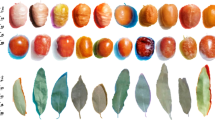Abstract
The present investigation was carried out during 2015–2017 to identify superior accessions of Garcinia lanceifolia Roxb., a highly medicinal fruit of Mizoram, North-east India. The ripe fruits of 25 selected accessions from six districts of Mizoram, north-east India were analyzed for fruit weight, fruit length, fruit diameter, fruit volume, pulp weight, peel weight, pulp: peel ratio, seed weight, seed length, seed diameter, number of seeds, TSS, acidity, ascorbic acid, reducing sugars and total sugars. The study reveals that there was significant variation among the accessions with respect to all these characters. Individual fruit weight ranged from 31.90 to 105.47 g; fruit volume 25.53–95.40 cm3; seed weight 12.98–46.98 g; peel weight 1.45–4.96 g; pulp weight ranged from 12.69 to 53.88 g. There was wide variation in chemical characters of the fruits also. TSS varied from 5.29 to 8.64%, titratable acidity varied from 3.27 to 5.72%, ascorbic acid 42.03–49.34 mg/100 g; total sugars 5.00–6.86%; reducing sugar ranged from 2.57 to 4.16%. From the results of the present investigation, MZU-HAMP-GC-1, MZU-HAMP-GC-2 and MZU-HAMP-GC-10 can be considered as elite G. lanceifolia Roxb. accessions for use in future breeding programmes.

Similar content being viewed by others
References
AOAC (1995) Official methods of analysis, 16th edn. Association of Official Analytical Chemists, Washington
Bouhadida M, Casas AM, Moreno MA, Gogorcena Y (2005) Genetic diversity of prunus rootstock using microsatellite markers. Acta Hortic 771:25–31
Chowdhury T, Handique PJ (2012) Evaluation of antibacterial activity and phytochemical activity of Garcinia lancifolia Roxb. Int J Pharma Sci Res 3:1663–1667
Cuong DH, Quang DV (2007) Estimating hydroxycitric acid in leaves, rinds, fruits of Garcinia oblongifoia champ. ex benth by HPLC. J Sci Technol Danang Univ 3:137
Dachriyanus D, Izati M, Fahmi R (2004) Antimicrobial compounds from the bark of Garcinia parvifolia Mig. Jurnal Matematika & Pengetahuan Alam 13(1):20–24
Doley P, Jha DK (2015) Antimicrobial activity of bacterial endophytes from medicinal endemic plant Garcinia lancifolia Roxb. Ann Plant Sci 4:1243–1247
Hazarika TK, Lalawmpuii B, Nautiyal BP (2013a) Studies on variability in physio-chemical characters of hatkora (Citrus macroptera Mont.) collections of Mizoram. Indian J Hortic 70:480–484
Hazarika TK, Merilyn L, Nautiyal BP (2013b) Genetic variability in physico-chemical characteristics of some pummelo collections from Mizoram. Indian J Hortic 70:431–434
Hazarika TK, Lalthlamuani, Lalchhanmawia J, Lalrinfeli, Nautiyal BP (2016) Variability in physico-chemical characteristics and selection of superior types among local pummelo (Citrus grandis (L.) Osbeck) germplasms from Mizoram, North East India. Curr Sci 111:1355–1361
Hazarika TK, Lalchhanmawia J, Lalrinfeli L, Shukla AC, Nautiyal BP (2017) Assessment of genetic variability in the endangered Citrus macroptera Mont. (“hatkora”) from Mizoram, north-east India. Genet Resour Crop Evol 64:321–330
Kar A, Borkakoti S, Borthakur SK (2008) Extended distribution of the genus Garcinia L. in Sonitpur district, Assam, India. Pleione 2:165–170
Korikanthimath VS, Desai AR (2006). Status of Kokum (Garcinia indica Choicy) in Goa. Compadium on Kokum (Garcinia indica), 2nd National Seminar on Kokum (Garcinia indica Choicy) held at Goa University during 4–5 Mar, 2005, pp 17–27
Kumar PS, Devi P, Choudhary VK, Kanwat M (2010) Evaluation of different mandarin, sweet orange rootstock species and cultivars under mild hill conditions of Arunachal Pradesh. Indian J Hortic 67:433–440
Kumar D, Lal S, Ahmed N (2015) Morphological and pomological diversity among Apricot (Prunus armeniaca) genotypes grown in India. Indian J Agric Sci 85(1):349–355
Mabberley DJ (2005) The plant book A, portable dictionary of the vascular plants, 2nd edn. Cambridge University Press, Cambridge, p 293
Meghwal PR, Azam MM (2004) Performance of some aonla cultivars in arid region of Rajasthan. Indian J Hortic 61:87–88
Muharni M, Supriyatna S, Bahti HH, Dachriyanus D (2009) Phenolic compound from the stem bark of manggis hutan (Garcinia bancana Miq.) and their antioxidant activity. Indones J Chem 9(2):321–327
Nabandith V, Suzui M, Morioka T, Kaneshiro T, Kinjo T, Matsumoto K, Akao Y, Iinuma M, Yoshimi N (2004) Inhibitory effects of crude alpha-mangostin, a xanthone derivative, on two different categories of colon preneoplastic lesions induced by 1, 2-dimethylhydrazine in the rat. Asian Pac J Cancer Prev 5(4):433–438
Panse VG, Sukhatme PV (1985) Statistical methods for agricultural workers. ICAR, New Delhi
Patil BP, Gawankar MS, Sawant DS, Pujari KH, Jambhale ND (2005) Cultivation of Konkan Amruta and Search for elite varieties. In: Preview of 2nd national seminar on kokum, 4–5th Mar. Goa University, Goa, pp 29–34
Prakash J, Maurya AN, Singh SP (2010) Studies on variability in fruit characters of jamun. Indian J Hortic 67:63–66
Rukachaisirikul V, Pailee P, Hiranrat A, Tuchinda P, Yoosook C, Kasisit J, Taylor WC, Reutrakul V (2003) Anti HIV-1 protostane triterpenes and digeranyl benzophenone from trunk, bark and stems of Garcinia speciosa. Planta Med 69:1141–1146
Singh IP, Singh S (2003) Exploration, collection and mapping of Citrus genetic diversity in India. Technical bulletin no. 7, NRC for Citrus, Nagpur, pp 230
Wahyuni FS, Lindsay TB, Dachriyanus DR, Jubahar J, Lajis NH, Sargent MV (2004) A new ring-reduced tetraprenyltoluquinone and a prenylated xanthone from Garcinia cowa. Aust J Chem 57:223–226
Yapattanphum C, Subhadrabandhu S, Sugiura A, Yonemori K, Utsunomiya N (2002) Utilization of some Garcinia species in Thailand. Acta Hortic 575(2):563–570
Author information
Authors and Affiliations
Corresponding author
Ethics declarations
Conflict of interest
The authors declare that there is no conflict of interest in whatsoever.
Rights and permissions
About this article
Cite this article
Hazarika, T.K., Lalnunsangi, C. Exploring genetic diversity of Garcinia lanceifolia Roxb. (Clusiaceae), a highly medicinal and endangered fruit of north-east India. Genet Resour Crop Evol 66, 61–69 (2019). https://doi.org/10.1007/s10722-018-0695-5
Received:
Accepted:
Published:
Issue Date:
DOI: https://doi.org/10.1007/s10722-018-0695-5




